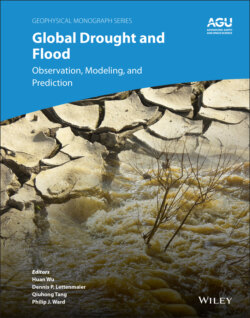Читать книгу Global Drought and Flood - Группа авторов - Страница 22
1.2.6. Groundwater
ОглавлениеProlonged meteorological droughts can severely affect groundwater levels and the problem is further exacerbated if it is followed by an anthropogenic drought (AghaKouchak, Feldman, et al., 2015; Alborzi et al. 2018). A decrease in groundwater recharge results in lower groundwater discharge and storage, a condition that is defined as a groundwater drought (Mishra & Singh, 2010). The lack of any imposed restriction for groundwater abstraction enhances hydrological drought, which is often overlooked due to poor understanding of hydrological cycle relations (Van Loon et al., 2016). The overuse of groundwater due to anthropogenic influences not only magnifies the drought condition, but also can cause permanent damage such as decreases in groundwater storage capacity and subsequent land subsidence (Famiglietti et al., 2011; Faunt et al., 2015; Taravatrooy et al. 2018). The lack of continuous spatiotemporal measurements of groundwater levels at a groundwater monitoring station (well) makes it difficult to characterize groundwater drought; however, with the launch of the GRACE satellites it has become possible to study the dynamics of water storages at a global scale (Wahr et al., 2006). The GRACE (2002–2017) and GRACE Follow‐On (2018 to present) satellites monitor changes in water storage compring groundwater, surface water reservoir, soil moisture, and snow water storage components.
The GRACE missions provide global changes in total water storage by converting gravity anomalies into changes of water equivalent height (Rodell & Famiglietti, 2002; Figure 1.9). The observed terrestrial water storage (TWS) from GRACE has spatial resolution of 150,000 km2 per grid that cannot be used for regional assessments; however, downscaling techniques are alternatives for obtaining data with finer resolution (Zaitchik et al., 2008). Recent studies are more focused on developing the Mass Concentration blocks (mascons) approach that fits intersatellite ranging observations from GRACE, unlike the previously applied standard spherical harmonic approach (Watkins et al., 2015). The mascons approach smoothes the process of implementing geophysical constraints that help filter out the noise. Studies by University of Texas Center for Space Research (Save et al., 2012), Goddard Space Flight Center (GSFC; Luthcke et al., 2013), and JPL (Watkins et al., 2015) have shown that mascons can present higher spatial resolution with lower uncertainties. Several studies evaluated the applicability of GRACE‐TWS changes for analyzing and monitoring drought (Famiglietti et al., 2011; Scanlon et al., 2012; Thomas et al., 2017). An example is the Standardized Groundwater Index (SGI), a quantile‐based index with values bounded between 0 and 1 and values above and below 0.5 indicate wet and dry conditions, respectively (Bloomfield & Marchant, 2013). A threshold of 0.2 identifies the onset of drought and a sustained drought of greater severity would be indicated by SGI values below that threshold. Li and Rodell (2015) introduced the Groundwater Drought Index (GWI), which is able to detect and monitor groundwater deficits by means of outputs from a Catchment Land Surface Model (CLSM). The GRACE Groundwater Drought Index (GGDI) was developed to evaluate California’s Central Valley groundwater drought using GRACE‐TWS observations (Thomas et al., 2017). It was found that GGDI is highly correlated to GWI, which uses measurements of groundwater level in situ as an input, suggesting that the groundwater storage anomalies obtained from GRACE can be used as valid input for groundwater drought indices.
Figure 1.9 Global map of annual water storage change for the period of 2002–2016 in the form of surface, underground, and ice and snow data collected by the Gravity Recovery and Climate Experiment (GRACE) mission.
(Courtesy of NASA’s earth observatory: https://earthobservatory.nasa.gov/images)
Nonetheless, a major limitation of GRACE when it comes to its application for drought monitoring is its monthly observations of TWS change. In addition, the derived GRACE‐TWS changes are limited to 17 years, which is insufficient for capturing climatological characteristics and drought analysis. Therefore, attempts have been made to reconstruct a longer time series of groundwater data utilizing both measurements in situ and statistical approaches such as artificial neural networks (Mohanty et al., 2015). To obtain higher spatial resolution data, GRACE observations can be assimilated into land surface models such as the CLSM (Koster et al., 2000) and the GRACE data assimilation system (GRACE‐DAS; Zaitchik et al., 2008).
